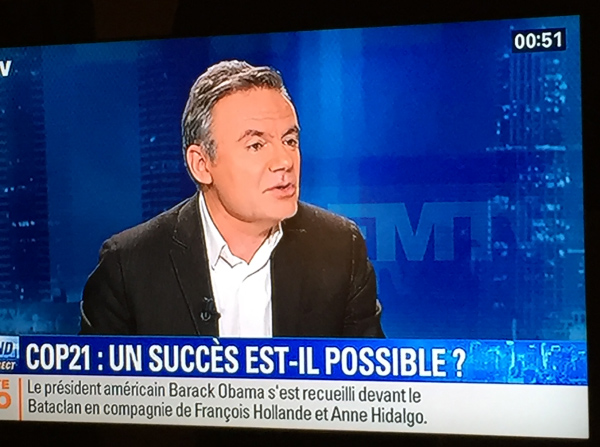PARIS—The question, raised again and again on French TV hours before the climate change talks in this city commence, can be understood even by those of us who cannot read or speak French. Is success possible, for the ambitious 21st Conference of Parties under the UN Framework Convention on Climate Change?
The ambition, in procedural terms, is for the 195 countries and the European Union (the “parties”) to agree on a new, legally binding treaty that will limit greenhouse gas emissions below the 2-degree Celsius threshold. In substantive terms, it is nothing less than to save the planet.
Is success possible? The last time the international community came close to reaching agreement on a new treaty applicable to both developed and developing economies, to replace the 1997 Kyoto Protocol, was in Copenhagen, Denmark, in 2009. But that conference ended in turmoil and uncertainty, in large part because of the contest of wills between China and the United States, the world’s two largest greenhouse gas emitters.
READ: LOOKBACK: Climate talks in Copenhagen in epic fail
It has taken six years of tedious work for the negotiation process to reach the same point. But five factors suggest that, despite the duplications and omissions of the negotiating draft, Paris will succeed.
French strategy. Unlike with the Copenhagen forum, the host government of COP21 has put the entire weight of its resources and its considerable prestige behind the effort to reach agreement. The effort may be best described as strategic diplomacy. France designated a high-level climate adviser and four climate envoys to discuss the prospects of a binding and universal agreement with as many countries as possible. French President Francois Hollande travelled extensively to sell the idea of agreement; he visited the Philippines last February, for instance, to sign the Manila Call to Action with President Benigno Aquino III. Even the hosting arrangements here at the Le Bourget conference venue reflect French inclusiveness: Previous COP hosts have been asked to chair parts of the conference. The result of over a year’s worth of diplomatic work is considerable goodwill.
Obama legacy. US President Barack Obama has learned from the debacle six years ago, and since last year has sought bilateral understandings with other major emitters such as China and Brazil. It seems clear that he is attempting to leave a legacy in environmental action as he heads into his last year in office, and despite facing an unsympathetic Congress. The announcement by Obama and Chinese President Xi Jinping in Beijing, in November 2014, of parallel initiatives in carbon cuts (China to “peak” by 2030, the United States to cut carbon dioxide emissions by 26 percent starting in 2025) committed the world’s two biggest emitters to a successful Paris conference. In June 2015, Obama and Brazilian President Dilma Rousseff made another joint announcement outlining ambitious climate goals.
Chinese commitment. Unlike in Copenhagen, where China’s resolve to back a strong climate treaty could be best described as wait-and-see, today China is helping lead the way on climate policy. XI, the most powerful Chinese leader since Mao Zedong, has very publicly backed his country’s increasingly ambitious carbon-cutting program; first in the joint announcement with Obama in Beijing, then again with Obama in Washington, DC last September, and then here in Paris, where his arrival (like that of Obama) has been tracked closely on both TV and in the French press.
Increasingly obvious impact. The emergence of more powerful storms, symbolized by the destructive power of super typhoon Haiyan (Yolanda), is only one of many indicators that the consequences of global warming are real and already serious. To extreme weather, add the rise in sea level (up by half a foot in the last century), the increase in global temperature (10 of the warmest years on record occurred in the last 12 years), shrinking ice sheets in Greenland and Antarctica, and warmer oceans (the reason for Yolanda’s unusual strength). As chair of the Climate Vulnerable Forum, which is holding a high-level side event on the first day of the Paris conference, President Aquino will be giving voice to the evidence for climate change.
Redefined negotiations. Not least, the redesign of the negotiation process, begun in Durban, South Africa in 2011, has obliged the parties to commit to reduction goals, called Intended Nationally Determined Contributions, or INDCs. On Sunday, Angola became the latest country to submit its climate action plan, bringing the total number of countries who have committed INDCs to 184.
READ: LOOKBACK: The last PH president at a climate conference
For these reasons, hopes are high that the Paris talks will end with an accord — a treaty that will be universal (applicable to all parties, unlike the Kyoto Protocol), legally binding, and ready to take effect in 2020. But will the treaty save the planet?
In whatever form the treaty will take by the end of negotiations late next week, the answer must be No. Taken together, the climate programs represented by the INDCs will cap global temperature rise by the end of the 21st century to 2.7 degrees — a still-catastrophic outcome. But environmental activists are hoping that the Paris treaty will include a strong and clear provision on periodic review. The priority, in their view, is to create the legal framework now, and then work on making the INDCs more ambitious over time.
RELATED STORY
PINAS TO PARIS: An Inquirer Group special report
